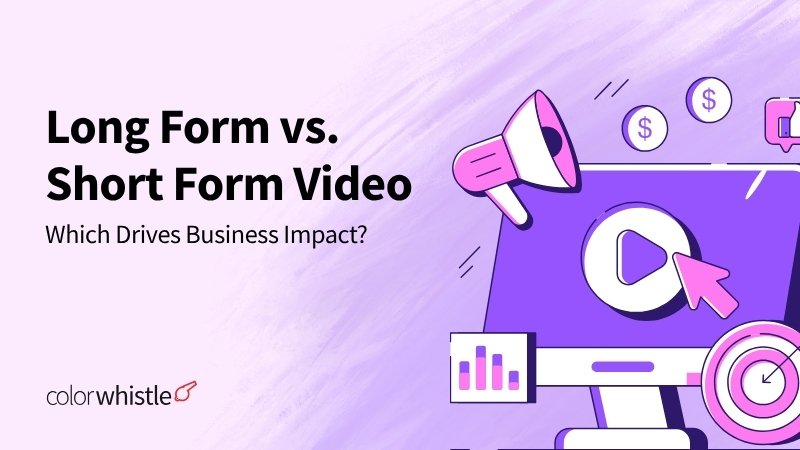So, you have decided that it’s time for a rebrand? Great! You have already crossed the hardest part – committing to a rebrand.
Letting go of what worked in the past to make changes to future-proof your brand requires forward-thinking. Congratulations – The hard part is behind you.
Rebranding without purpose or strategy is a recipe for disaster. Beyond sketches and designs, rebranding your company requires a strong company alignment and the flexibility to move ahead with the rebranding.
By working on a variety of rebranding projects, our ColorWhistle team has learned some amazing things including types of rebranding, the process, and some other important things that you need to remember when you want to reinvent the look of your company. We have also put together a rebranding checklist to make sure you don’t miss out on anything important.
Let’s jump right into the topic and find out how rebranding can keep your company in shape.
What is Rebranding?
Rebranding is changing an organization’s name, logo, colors, or other structural parts of the brand image of a company to allow new perceptions to form in the minds of consumers, investors, and other stakeholders.

What Are the Types of Rebranding?
We have used our knowledge to categorize branding into 3 major types. This will help you identify the best type of rebranding that will fit your company.
1. Brand Refresh
This is the most common type of rebranding that refreshes your current brand. If there has been a slight change in the goals and objectives of your company, or if your company logo is outdated, your branding agency will opt for this. Tweaks and changes will be made for your visual identity to help you keep up-to-date with the latest trends that consumers want.
2. Brand Merger
A brand merger happens when there is a merger or acquisition or when your company welcomes a new management. This type of brand merger combines two or more platforms into one. For example, combining two logos to make one single logo.
3. Full Rebrand
A complete overhaul of a brand is a serious decision that impacts every aspect of your business. Companies will opt for a full rebrand when their products or services fail to resonate with the audience and keep them from reaching their maximum potential. With a complete rebrand, there will be little to no resemblance to your previous brand.
What Are the Top Reasons for Rebranding?
The motivation behind a rebrand is a combination of several factors. Here are the top reasons why corporates rebrand.
- Changes in business ownership such as mergers, acquisitions, and demergers usually result in an immediate rebranding
- Changes in brand positioning and the brand promise of a company results in rebranding to make the transformation visible to all the stakeholders
- Changes are necessary if the organization plans to use its brand internationally
- Changes in the market situation or digitalization demand companies to reinvent themselves to better fit the current digital age
- Changes are made to remove any negative association with a brand
- Changes in the organizational structure like the appointment of a new CEO
- Changes are made to increase business returns and save costs
In addition to these common reasons, there are a multitude of other reasons for rebranding. No matter the reason, it is important to make the right choice. Additionally, you may have to convince all the stakeholders in your organization to opt for a rebrand.
What Does a Rebranding Process Look Like?
Every business is unique. But, there are some core building blocks that will be present in every rebranding process. Your rebranding process will look something like this.
1. Discovery Phase
Your rebranding agency or brand team will dive deep into your current brand and do thorough research to understand your business context. In this stage, these are the areas that will be given the utmost importance to:
Competitor research
Finding points to set you apart from competitors
Market research
Discovering what your customers want and expect from you
2. Creative Phase
Once all the data is collected related to where your current brand is and where you likely want to be, the next stage in the rebranding process is to develop your visual identity. In this phase, importance will be given to the following:
Develop a messaging approach
Elevator pitch, user personas, and key features and benefits your product or service offers
Visual identity
like color palette, logo, fonts, artwork, illustration, and any other brand marques
3. Execution Phase
Your rebranding agency or team will be ready with the approaches, visuals, and brand names and taglines if applicable. Here are some aspects that will be concentrated in this phase.
Collect feedback from stakeholders
Giving feedback to the creative team so that contradictions can be removed before the actual execution
Check the brief
Review everything on the brief to check if everything is covered to your satisfaction and if the revisions match the original scope
Once the feedback is resolved, the rebranding agency will give you the final deliverables.
Also Read
A Simple Rebranding Checklist
We have put together this rebranding checklist, which will be useful for any business that is planning to take a bold move to secure the future of their company by refreshing their brand. Make sure you tick all these for a successful rebranding.
About Your Company
- Mission, vision, and values
- Brand style guide
- Tagline/slogan description
Marketing Materials
- PowerPoint presentations
- Brochures, flyers and other education materials
- Case studies, white paper, testimonials, etc
- Newsletter/e-newsletter templates
- Digital banner ads, TV and radio spots if applicable
- Videos and product demos
- Launch email campaigns and PPC campaigns notifying customers
Human Resource
- Employee agreement
- Training materials
Other Points To Keep In Mind
- Set up a plan to communicate the changes internally
- Fix deadlines and goals
- Device a plan to get proper trademarks for your new brand
- Hire a lawyer to make sure all the legal paperwork is proper (optional)
Digital Assets
- Web domains
- Changes in website content
- Update visuals in your website
- Social media accounts (new social media graphic designs and notify all your followers)
- On-page SEO: titles, keywords, meta descriptions, etc
- Web feed (RSS) links
- Business directories and web directories
- Google My Business Listing
Internal
- Business cards, email signatures, and addresses
- Letterhead, envelopes, labels, and any other related items
- Server and file names
- Computer logins
- New email addresses and signatures
Legal and finance
- Tax documents
- Contracts, statements, and invoices
- Accounting software
What Are the Key Components of Rebranding?
The essentials involved in the rebranding is crucial for the entire project because they are the foundation upon which the other parts are built. We have listed some of the key components that you need to pay attention to when you are rebranding.
Values
Brand values are the heart of every company’s culture. They must always be future-proof and actionable. So, if you establish your values properly, you will be able to take your rebrand to the next level
Logo
The logo of your brand has to reflect who you are. Use your brand values as a base to select color schemes, shapes, and lineage that aligns with your company
Website
Your website is the most important piece of branding you have. Most people will visit it before making a purchasing decision. So, make sure it’s user friendly
Message
A mission statement describes your company from an internal point of view. Whereas brand message is externally focused. So ensure it makes a promise and fulfills the need for your products or services as it is the value proposition
What Are Some Successful Rebranding Case Studies?
Here are some successful rebranding examples for your inspiration.
1. Made in Bhutan
The country developed a strategy called ‘Made in Bhutan‘ to promote its goods, services, and tourism. The rebranding helped the country to be associated as a country that is happy, strong, and a provider of high-quality tourism. Click here to view the complete case study.
2. Uber
The company was struggling internally and was looking for a much-needed change. So, they decided to rebrand to gain a fresh perspective and to get a solid re-starting point. Their rebranding communicated safety and trust to the audience. Click here to view the complete case study.
3. Typeform
The company wanted to narrow down its focus, be more human-centric, and distinguish themselves from the competitors. So they decided to rebrand. Post the rebrand, their new quirky visuals showed empathy and helped to establish a new emotional connectivity with the users. Click here to view the complete case study.
4. Dunkin
They wanted to move away from just being a donuts seller and wanted to appeal to coffee lovers and expand their customer base. Their new typography and brand name change helped to achieve everything wanted. Click here to view the complete case study.
5. Ogilvy
The advertising, marketing, and public relations agency.decided to re-brand to focus on their heritage. The rebrand truly transformed them into a classy mark. Click here to view the complete case study.
Also Read
6. BMW
Recently the automotive giant redesigned its logo to represent more openness and clarity. It has been the biggest redesign in over 100 years. Click here to view the complete case study
7. Hewlett Packard
The logo of the company’s logo was dull, beige, and old-fashioned. So they decided to revamp the logo design. The new logo design led to an immediate stir in the design world. Click here to view the complete case study.
8. Mindtree
The IT solutions company took a rebranding initiative and announced a new mission, values, and logo. The aim behind the rebrand was to of becoming a billion-dollar company. Click here to learn more.
9. Wipro
This leading global information technology introduced a new brand identity to rearticulate its values and keep up with the clients’ expectations. Click here to learn more.
10. Pepsi
The soft drink company rebranded its cans with a new tagline ‘For the Love Of It’ with an aim to celebrate the pop and fizz. Click here to learn more.
11. Coco-Cola
The company launched new branding and new flavors for its diet coke recently to capture its younger audience. Click here to learn more
Looking for B2B Marketing Agency Services?
Seize and experience the transformative impact of B2B Marketing Agency Services & Solutions with ColorWhistle.
Are You Thinking About Rebranding?
The benefits of rebranding will not only impact your overall marketing efforts, but they can also make your company more profitable. Reaching new potential clients, standing out from your competitors, showcasing your expertise, and expanding the influence of your products and services are some of the benefits you can enjoy by giving your brand a new look.
That said, there is a lot to consider when rebranding. It requires a commitment to your culture, clients, and bottom line. So seeking the help of a professional rebranding agency can help you make this important transition stress free.
A rebrand can be as simple as developing a new strapline for your business, name change, logo redesign, or even a website redesign. No matter the size of a rebrand, a professional agency can carry out the work with diligence and care.
If you’re considering rebranding your business, our ColorWhistle branding experts can help you. From initial planning to the final roll-out, we will formulate an excellent rebranding strategy that will help your business grow or expand to new markets. Contact us or give us a call +1 (210) 787-3600 anytime. We look forward to working with you.

In quest of the Perfect B2B Marketing Services Agency?
Be unrestricted to click the other trendy writes under this title that suits your needs the best!





